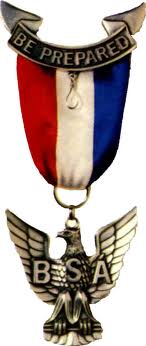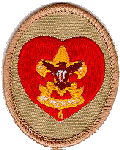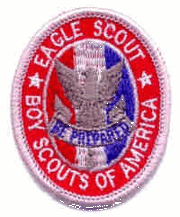
The ladder of advancement or "Trail to Eagle" in Scouting includes seven ranks from Scout to Eagle. When a scout is taught a skill or accomplishes a requirement, he must have his patrol leader, a staff member, or scoutmaster sign off the requirement in his handbook. Once all requirements have been met, the scout must have a Scoutmaster Conference with the Scoutmaster. Finally, the scout must attend a Board of Review and show the Board Examiners that he has completed all the requirements. After passing the BOR, the scout will be presented with his new rank at the next Troop Meeting. They will receive a rank patch to go on their left breast pocket.
As a side note, to commemorate the 100 years of scouting, in 2010, all scout patches had a special border displaying 1910 and 2010.
Scout[]

The most basic rank in Scouting. It is given to all new recruits and only requires that the scout join the Troop.
Tenderfoot[]

Tenderfoot is easily achievable by all new scouts. It requires a basic knowledge of the Troop, their patrol, the Scout uniform, and the Scout Oath and Law. A Tenderfoot scout is also expected to know the basics of hiking, knot tying, the buddy system, and poisonous plants. Finally, a Tenderfoot scout must also complete a very basic physical fitness regimen over 30 days.
Second Class[]

A Second Class scout must know how to orient a map, the basics of leave-no-trace camping, the rules for a safe swim, basic first aid, and how to identify local animals. He must also have completed a short hike, preformed at least one hour of community service, participate in a Flag Ceremony, and complete a drug education program like DARE.
First Class[]

First Class builds on what the scout learned for Second Class. He now must identify local plants in addition to wildlife, he must show how to orient himself without a compass, show a more in depth understanding of first aid, and must complete the BSA Swim Test. A First Class scout must also show his ability to organize a meal plan and cook it. He must also understand the rights and responsibilities of a citizen and have participated in several troop events. The scout must also show a knowledge of lashing and several knots.
Star[]

Star is the first of the higher set of ranks. A Star scout must participate in service projects, remain active in the Troop, and hold a Position of Responsibility. In addition, he must have at least six merit badges and four of those badges must be Eagle required. (They could all be Eagle required.)
Life[]

Life further builds on the requirements of Star. Five more badges are required (three of them Eagle required). The service requirements and Position of Responsibility requirements are increased and extended. Life scouts are also expected to take a more active role in leading and teaching the Troop's younger scouts basic skills.
Eagle[]

Eagle continues the requirements for Life and Star to their conclusion in the pinnacle of Scouting. A Position of Responsibility is required and the scout must acquire ten more merit badges (including all the remaining Eagle required). Instead of simply preforming service, an Eagle scout must plan and lead a large scale service project of his own. Finally, he must attend and pass a special Eagle Board.
Eagle Palms[]
After achieving the rank of Eagle, a scout may earn an additional palm every three months. To earn each palm, the scout must acquire five more merit badges and remain an active and upstanding member of his troop.
For more information see Eagle Scouts.